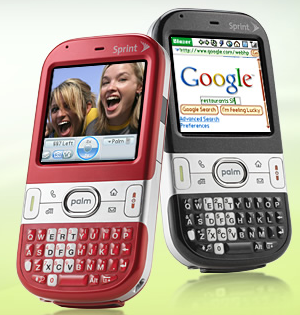Palm: Centro will nibble at Treo sales

Palm says its new Centro smartphone is likely to cannibalize some Treo sales and bring the company's average selling price down for the quarter ending Nov. 30.
The company reported its fiscal first quarter results on Monday and delivered a net loss of $800,000, or a penny a share, on revenue of $360.8 million. Excluding charges, Palm reported first quarter earnings of $16.5 million, or 16 cents a share. Those results were in line with Wall Street expectations.
However, Palm trimmed its projections for the fiscal second quarter due to aggressive pricing moves and the company's plan to grab share. Meanwhile, average selling prices for Palm's devices are expected to fall by at least 10 percent. Why? The Centro, Palm's latest smartphone, sells for $99. That price, which may bring in more customers, will weigh on Palm's profit margins. Palm will also cut prices on its older Treo models.
Add it up and Palm is expected to report revenue of $370 million to $380 million and a net loss of 3 cents a share to a penny a share. Excluding charges, Palm expects to report a profit of 6 cents a share to 8 cents a share. Gross margins are roughly supposed to be in the 33 percent to 34 percent range.
Needless to say this outlook didn't go over too well with analysts. Wall Street was expecting second earnings of 10 cents a share excluding items. Oppenheimer analyst Lawrence Harris also noted that the Centro may not sell enough units to make the price pain worth it.
"Our impression of the Centro is that its keyboard will be too small for many users," says Harris. That point remains to be seen. David Berlind got an overview of the Centro at the Digital Life conference last week.
The more important issue with the Centro is that Palm doesn't have a high-end Treo to offset falling average selling prices (ASPs). "Without compelling new high-end phones, Palm’s near-term prospects remain challenging in our opinion," says Merrill Lynch analyst Vivek Arya in a research note. "Overall, Palm’s smartphone ASP is getting pressured from the success of low-end Centro ($249-299 ASP) models, and the lack of offsetting high-end Treo ($500 ASP) models."
The earnings conference call (transcript via SeekingAlpha) had Palm execs playing a bit of defense, but there were a few key takeaways. Among them:
Palm expects Centro to be a nice stocking stuffer. Palm CEO Ed Colligan said he expects good holiday demand for "Sprint customers." Sprint has a 90-day exclusive deal with Palm on the Centro. He has a point. At $99, the Centro could be a good option for many folks. The $99 price point is clearly my favorite--that's why I have a Motorola Q instead of a Treo. Palm's game plan is to bring the brand to traditional cell phone customers. Palm executives said that early Centro demand has been strong.
Colligan says:
Obviously one of the things we are doing right now is trying to drive for more customer acquisitions and more growth. We expect to have higher sell-through with regard to our new products coming out, which will bring more customers to the Palm brand.
While the Centro is targeted at a different niche of customers, there will be some cannibalization. Colligan noted that Palm has planned for some cannibalization as the Centro takes away Treo sales. Colligan says:
We have estimated what we believe will happen relative to Centro and the 755p for instance or the 700p. That's all part of our guidance. Again, we're going to really try to target a different customer set, different audience to try to expand our reach. There are definitely customers who still would prefer the larger keyboard, larger battery, more robust expansion capabilities and the bigger screen. So we think all those things will come into play as people consider their purchases.
Palm's next generation platform update. Colligan says he expects the latest Palm OS to be available "by the end of the next calendar year." Colligan says:
I would say that the operating system, the platform development effort has gone as well as could possibly be expected and we're excited about how that's been coming along and feel like it is on schedule. Everyone always would like to do things faster, of course, like to have it yesterday, but it's certainly within our expectations of what we expected and part of the reason why we've even focused more energy on it is because we are more excited about it than ever before, and that's when you start really seeing it working in devices and so forth.
Sticking to the enterprise roots. Colligan also discussed enterprise email support. "Our second major focus is the business-to-business email market in close partnership with Microsoft. We believe the days where a CIO feels the need to install a third party server to deliver secure and reliable email are quickly coming to an end. Today if your organization has installed Exchange 2003 with Service Pak II or Exchange 2007 you can receive secure, behind the fire wall email without third party server software directly to any Palm device, either Palm OS or Windows Mobile-based, right out of the box," says Colligan.
The company isn't taking a demand hit at the expense of the iPhone. Colligan says:
It's hard to estimate whether or not there would have been more upside in our volume without the iPhone, but I can tell you that through the weeks that that was coming out and shipping initially and lately, that we have seen very little change in our sell-through volumes and in fact even at AT&T very little change. So I'm sure it's had some impact, but not anything that is significant.
Nevertheless, Palm says it is pricing aggressively. Palm has launched mail-in rebates for many Treo models to stoke demand.
